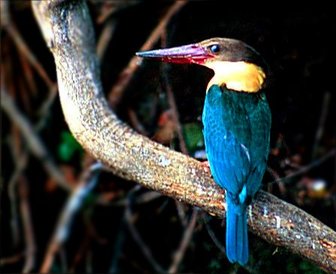Stork-billed Kingfisher
The Stork-billed Kingfisher, Pelargopsis capensis , is a tree kingfisher which is widely but sparsely distributed in tropical south Asia from India and Sri Lanka to Indonesia. This kingfisher is essentially resident throughout its range.

Original source: Photography of Kousik Nandy and Sumana Paul
Author: Kousik Nandy and Sumana PaulPermission(Reusing this file)own work
Permission: GNU Free Documentation License
The Stork-billed Kingfisher is classified as Least Concern. Does not qualify for a more at risk category. Widespread and abundant taxa are included in this category.
The Stork-billed Kingfisher, Pelargopsis capensis (formerly Halcyon capensis), is a tree kingfisher which is widely but sparsely distributed in tropical south Asia from India and Sri Lanka to Indonesia. This kingfisher is essentially resident throughout its range. Pelargopsis capensis burmanica by Keulemans This is a very large kingfisher, 35 cm in length. The adult has a green back, blue wings and tail, and grey head. Its underparts and neck are buff. More
of the Stork-billed Kingfisher is laboured and flapping, but direct. Sexes are similar. There are 15 races, mostly differing in plumage detail, but P. c. gigantea of the Sulu Islands has a white head, neck and underparts. The call of this noisy kingfisher is a low and far reaching peer-por-por repeated every 5 seconds or so as well cackling ke-ke-ke-ke-ke-ke. Stork-billed Kingfisher is a species of a variety of well-wooded habitats near lakes, rivers or coasts. More
Stork-billed Kingfishers are the largest Kingfishers found in Singapore. But they are rarely sighted because they are shy and less noisy than other Kingfishers. Stork-billed Kingfishers eat mainly fishes, using their large heavy bills to good effect to catch and kill their prey. From their perch, usually about 2-4 m above the water, they will plunge into the water. They also eat crabs, insects, frogs, mice, lizards, birds and their eggs. Prey is brought back and whacked senseless against the perch. More
Stork-billed Kingfisher is a species of a variety of well-wooded habitats near lakes, rivers or coasts. It perches quietly whilst seeking food, and is often inconspicuous despite its size. It is territorial and will chase away eagles and other large predators. This species hunts fish, frogs, crabs, rodents and young birds. More
opportunity to digiscope a Stork-billed Kingfisher (Halcyon capensis) trying to swallow a catch bigger than his head, sent tremors to my fingers as I nervously raced against time to capture this gorgeous and disproportionately colourful bird framed in that moment of time - time that stood still… just for me. The Stork-billed Kingfisher belongs to the family of Alcedinidae and is one of the 86 species in the world under the sub-family description of Halcyon. The word ‘HALCYON’ is derived from Greek mythology. More
Gardens keeping watch on a pair of Stork-billed Kingfisher (Halcyon capensis) around the Symphony Lake. Normally, the kingfisher came out between 7 am and 12 noon, perching on a branch of its favourite tree, keeping watch on the water below. “Out of the total 10 days I went there, the last day was a lifer for me. Both the female and the male came out and fished at the same area, but on different branches. This made me suspect that it’s juvenile was hungry. More
Stork-billed Kingfisher (Halcyon capensis) This is the largest Kingfisher in Malaysia and Singapore, and is found mainly at rivers and large waterbodies. I found this in 2007 at the Sungei Buloh Wetlands Reserve in Singapore amongst the mangrove trees, and in March, 2009 in mainland Penang, Malaysia. The Singapore bird is a ringed bird and may well be resident. More
* Stork-billed Kingfisher, Pelargopsis capensis : The Stork-billed Kingfisher, Pelargopsis capensis (formerly Halcyon capensis), is a tree kingfisher which is widely but sparsely distributed in tropical south Asia from India and Sri Lanka to Indonesia. This kingfisher is essentially resident throughout its range. This is a very large kingfisher, 35 cm in length. More
* Stork-billed Kingfisher (Pelargopsis capensis) See more Advertisement Related Tags - Strange Related News - more Strange news Track this Photo - * * email photo to a friend NowPublic * Contact * Blog More
Stork-billed Kingfisher Halcyon capensis - A very large (38cm) predominately freshwater kingfisher with a huge coral-red bill (which gives it its name). Dark brown cap, It has pale orange collar and under parts, while the upper parts are blue-green. While the tail is fairly long, the feet are small and red. It has a loud noisy ringing call kee kee kee which can sound rather raptor-like. Fairly common in most of the region except the northwest. More
The Stork-billed Kingfisher (Pelargopsis capensis) is one of the largest resident kingfishers in Singapore. Easily identified by its size and its massive bright red bill, its main prey is fish which it hunts by perching quietly on the branches of a tree near the riverbank or lakeside. Upon catching one, it will proceed to whack its hapless prey senseless on the branch with its powerful bill, and then proceed to consume it. p. More
Stork-billed Kingfisher, Thailand, Khoa Yai Feb 2007 © Benjamin Schwartz - Tropical Birding Tropical Birding Send this as a postcard Stork-billed Kingfisher - Stork-billed Kingfisher, Goa, Arpora November 2007 © steve morgan www.wingedimages.fotopic. More
Stork-billed Kingfisher (Halcyon capensis), also called Brown-headed Stork-billed Kingfisher (Pelargopsis capensis). This bird is a rare visitor. Locally called Bada Kilkila or Bada Kila, it is found in the wetlands of Haryana. More
Stork-billed Kingfisher Pelargopsis capensis Next species >>> Adult, Zuari River, Goa, India, November 2007 Adult, Zuari River, Goa, India, November 2007 Adult, Zuari River, Goa, India, November 2007 Adult, Parsham, Goa, India, November 2007 Adult, (with adult Black-capped Kingfisher) Siolim rice fields, Goa, India, November 2007 Adult, Siolim rice fields, Goa, India, November 2007 © Kit Day - Canon 1D Mark III, 500mm f4 IS, 1. More

Original source: Brian Gratwicke
Author: Brian Gratwicke
Permission: Some rights reserved
Family : Alcedinidae
Genus : Pelargopsis
Species : capensis
Authority : (Linnaeus, 1766)

